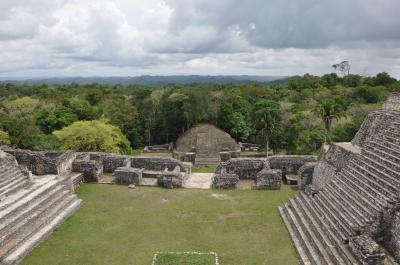The role of climate change in the development and demise of classic Maya civilization, ranging from AD 300 to 1000, has been controversial for decades because of a lack of well-dated climate and archaeological evidence. But an international team of archaeologists and earth science researchers has compiled a precisely dated, high-resolution climate record of 2,000 years that shows how Maya political systems developed and disintegrated in response to climate change.
In an article published Nov. 9 in the journal Science, the researchers outlined how they reconstructed rainfall records from stalagmite samples collected from Yok Balum Cave, located nearly three miles from ancient city of Uxbenka, in the tropical Maya Lowlands in southern Belize. They compared their findings to the rich political histories carved on stone monuments at Maya cities throughout the region.

An international team of archaeologists and earth science researchers has compiled a precisely dated, high-resolution climate record of 2,000 years that shows how Maya political systems developed and disintegrated in response to climate change.
(Photo Credit: Douglas Kennett, Penn State)
"Unusually high amounts of rainfall favored an increase in food production and an explosion in the population between AD 450 and 660" said Dr. Douglas Kennett, lead author and professor of anthropology at Penn State. "This led to the proliferation of cities like Tikal, Copan and Caracol across the Maya lowlands. The new climate data show that this salubrious period was followed by a general drying trend lasting four centuries that was punctuated by a series of major droughts that triggered a decline in agricultural productivity and contributed to societal fragmentation and political collapse. The most severe drought (AD 1020 and 1100) in the record occurs after the widespread collapse of Maya state centers (referred to as the Maya collapse) and may be associated with widespread population decline in the region."
"Over the centuries, the cities suffered a decline in their populations and Maya kings lost their power and influence" Dr. Kennett said. "The linkage between an extended 16th century drought, crop failures, death, famine and migration in Mexico provides a historic analog, supported by the cave stalagmite samples, for the socio-political tragedy and human suffering experienced periodically by the Classic Period Maya."

An international team of archaeologists and earth science researchers has compiled a precisely dated, high-resolution climate record of 2,000 years that shows how Maya political systems developed and disintegrated in response to climate change.
(Photo Credit: Claire Ebert, Penn State)
The rich archaeological and historical records of the Maya provide an opportunity to examine the long-term effects of climate change for both the development and disintegration of complex sociopolitical systems like our own, according to Dr. Kennett, an internationally known expert on the human effects of global climate change and the environmental impacts of expanding populations.
"The effects of climate change are complex and play out over multiple time scales," he added. "Abrupt climate change is only part of the story. In addition to climate drying and drought, the preceding conditions stimulating societal complexity and population expansion helped set the stage for later stress on their societies and the fragmentation of political institutions."

An international team of archaeologists and earth science researchers has compiled a precisely dated, high-resolution climate record of 2,000 years that shows how Maya political systems developed and disintegrated in response to climate change.
(Photo Credit: Douglas Kennett, Penn State)
Source: Penn State